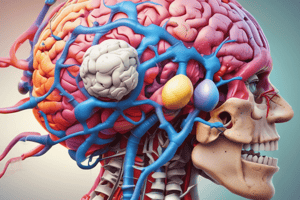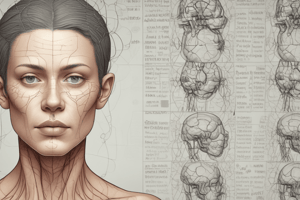Podcast
Questions and Answers
The cranial nerve nuclei are detailed within the internal structure of the brainstem.
The cranial nerve nuclei are detailed within the internal structure of the brainstem.
True (A)
Cranial nerves with motor nuclei extending to skeletal muscle send fibers via autonomic ganglion cells for peripheral relay.
Cranial nerves with motor nuclei extending to skeletal muscle send fibers via autonomic ganglion cells for peripheral relay.
False (B)
The sensory nuclei of cranial nerves contain the cell bodies of primary, first-order sensory neurons.
The sensory nuclei of cranial nerves contain the cell bodies of primary, first-order sensory neurons.
False (B)
The mesencephalic trigeminal nucleus houses the cell bodies of the first neuron, part of the proprioceptive pathway from muscles of the orbit, face and tongue.
The mesencephalic trigeminal nucleus houses the cell bodies of the first neuron, part of the proprioceptive pathway from muscles of the orbit, face and tongue.
The oculomotor nerve nuclei consist of one motor nucleus and one additional parasympathetic, contributing to pupillary control.
The oculomotor nerve nuclei consist of one motor nucleus and one additional parasympathetic, contributing to pupillary control.
The trochlear nerve nucleus is situated near the midline of the floor of the midbrain at the level of the superior colliculus.
The trochlear nerve nucleus is situated near the midline of the floor of the midbrain at the level of the superior colliculus.
The trigeminal nerve contains one motor nucleus responsible for mastication and three sensory nuclei which are distinct.
The trigeminal nerve contains one motor nucleus responsible for mastication and three sensory nuclei which are distinct.
The Edinger-Westphal nucleus projects to the ciliary ganglion to control the sphincter pupillae and ciliary body.
The Edinger-Westphal nucleus projects to the ciliary ganglion to control the sphincter pupillae and ciliary body.
The main sensory nucleus of the trigeminal nerve is located in the lower spinal cord.
The main sensory nucleus of the trigeminal nerve is located in the lower spinal cord.
The motor nucleus of the trigeminal is positioned off centre, deep to the floor of the third ventricle, within the upper pons.
The motor nucleus of the trigeminal is positioned off centre, deep to the floor of the third ventricle, within the upper pons.
The spinal nucleus of the trigeminal nerve, responsible for pain and temperature sensation from the trigeminal area, extends superiorly into the pons and medulla.
The spinal nucleus of the trigeminal nerve, responsible for pain and temperature sensation from the trigeminal area, extends superiorly into the pons and medulla.
The abducent nucleus, controlling the lateral rectus muscle, is situated near the midline in the pons, specifically anterior to the facial colliculus in the floor of the fourth ventricle.
The abducent nucleus, controlling the lateral rectus muscle, is situated near the midline in the pons, specifically anterior to the facial colliculus in the floor of the fourth ventricle.
The superior salivary nucleus, a visceral motor nucleus of the facial nerve, provides secretomotor innervation to the pterygopalatine and sublingual ganglia, mainly for lacrimal and salivary secretion.
The superior salivary nucleus, a visceral motor nucleus of the facial nerve, provides secretomotor innervation to the pterygopalatine and sublingual ganglia, mainly for lacrimal and salivary secretion.
The cochlear nuclei, associated with hearing, are ventrally and dorsally located within the superior cerebellar peduncle in the medulla.
The cochlear nuclei, associated with hearing, are ventrally and dorsally located within the superior cerebellar peduncle in the medulla.
The inferior salivary nucleus, associated with the glossopharyngeal nerve, is located adjacent to the facial nucleus in the upper pons and provides secretomotor innervation for parotid secretion via the otic ganglion.
The inferior salivary nucleus, associated with the glossopharyngeal nerve, is located adjacent to the facial nucleus in the upper pons and provides secretomotor innervation for parotid secretion via the otic ganglion.
The nucleus of tractus solitarius, a sensory nucleus, receives taste fibers from the posterior third of the tongue via the glossopharyngeal nerve and from the epiglottis via the vagus nerve.
The nucleus of tractus solitarius, a sensory nucleus, receives taste fibers from the posterior third of the tongue via the glossopharyngeal nerve and from the epiglottis via the vagus nerve.
The dorsal motor nucleus of the vagus nerve, a visceral motor nucleus, is located below the hypoglossal trigone in the upper medulla and innervates skeletal muscle of thoracic and abdominal viscera.
The dorsal motor nucleus of the vagus nerve, a visceral motor nucleus, is located below the hypoglossal trigone in the upper medulla and innervates skeletal muscle of thoracic and abdominal viscera.
The nucleus ambiguus, a branchial motor nucleus, contributes to the cranial part of the accessory nerve, which innervates skeletal muscles of the palate and pharynx, with fibers joining the hypoglossal nerve.
The nucleus ambiguus, a branchial motor nucleus, contributes to the cranial part of the accessory nerve, which innervates skeletal muscles of the palate and pharynx, with fibers joining the hypoglossal nerve.
The spinal part of the accessory nerve originates from the anterior horn cells of the upper five or six thoracic segments of the spinal cord and innervates the sternocleidomastoid and trapezius muscles.
The spinal part of the accessory nerve originates from the anterior horn cells of the upper five or six thoracic segments of the spinal cord and innervates the sternocleidomastoid and trapezius muscles.
The hypoglossal nucleus, a somatic motor nucleus, is located near the midline below the vagal trigone of the upper medulla and controls the muscles of the larynx.
The hypoglossal nucleus, a somatic motor nucleus, is located near the midline below the vagal trigone of the upper medulla and controls the muscles of the larynx.
Flashcards
Cranial Nerve Nuclei
Cranial Nerve Nuclei
Groups of neuron cell bodies located within the brainstem responsible for the cranial nerves functionalities.
Motor Nuclei
Motor Nuclei
Nuclei that send fibers directly to skeletal muscles for voluntary movements.
Visceral Nuclei
Visceral Nuclei
Nuclei that connect to cardiac and smooth muscles and glands, sending fibers to autonomic ganglia.
Sensory Nuclei
Sensory Nuclei
Signup and view all the flashcards
First Sensory Neuron
First Sensory Neuron
Signup and view all the flashcards
Oculomotor Nerve Nuclei
Oculomotor Nerve Nuclei
Signup and view all the flashcards
Trochlear Nerve Nucleus
Trochlear Nerve Nucleus
Signup and view all the flashcards
Trigeminal Nerve Nuclei
Trigeminal Nerve Nuclei
Signup and view all the flashcards
Mesencephalic Nucleus
Mesencephalic Nucleus
Signup and view all the flashcards
Main Sensory Nucleus
Main Sensory Nucleus
Signup and view all the flashcards
Spinal nucleus
Spinal nucleus
Signup and view all the flashcards
Abducent nucleus
Abducent nucleus
Signup and view all the flashcards
Facial nerve nuclei
Facial nerve nuclei
Signup and view all the flashcards
Vestibulocochlear nerve nuclei
Vestibulocochlear nerve nuclei
Signup and view all the flashcards
Glossopharyngeal nerve nuclei
Glossopharyngeal nerve nuclei
Signup and view all the flashcards
Vagus nerve nuclei
Vagus nerve nuclei
Signup and view all the flashcards
Accessory nerve nuclei
Accessory nerve nuclei
Signup and view all the flashcards
Hypoglossal nucleus
Hypoglossal nucleus
Signup and view all the flashcards
Nucleus of tractus solitarius
Nucleus of tractus solitarius
Signup and view all the flashcards
Dorsal motor nucleus of vagus
Dorsal motor nucleus of vagus
Signup and view all the flashcards
Study Notes
Cranial Nerve Nuclei Summary
- Cranial nerve nuclei are located within the brainstem.
- Motor nuclei for skeletal muscles (somatic or branchial) send fibers directly to the muscles.
- Nuclei for cardiac/visceral/glandular muscles (visceral) relay fibers through autonomic ganglia.
- Sensory cranial nerve nuclei contain second-order neuron cell bodies.
- First-order sensory neuron cell bodies are in ganglia outside the CNS (like posterior root ganglia).
- Sensory fibers from cranial nerve nuclei project to motor nuclei, cerebellum, and thalamus.
- Trigeminal mesencephalic nucleus is an exception: it contains first-order neuron cell bodies for proprioception from the orbit, face, and tongue.
Oculomotor Nerve Nuclei
- Two motor nuclei.
- Somatic: near the midbrain aqueduct midline, supplying superior, medial, inferior rectus, inferior oblique, levator palpebrae superioris muscles
- Visceral (Edinger-Westphal nucleus): cranial to the somatic part, sending fibers to the ciliary ganglion for the sphincter pupillae and ciliary body.
Trochlear Nerve Nucleus
- Motor (somatic) nucleus near the midbrain aqueduct, supplying superior oblique muscle.
Trigeminal Nerve Nuclei
- One motor and three sensory nuclei.
- Motor (branchial): located in the pons near the fourth ventricle floor, for mastication muscles, mylohyoid, and tensor palati.
- Sensory (somatic):
- Mesencephalic nucleus in the midbrain, for proprioception (muscles of mastication, face, tongue, and orbit).
- Main sensory nucleus in the upper pons, for touch from the trigeminal area.
- Spinal nucleus in the lower pons and medulla, for pain and temperature from the trigeminal area. (Continuous with spinal cord's gelatinous substance). Afferent from glossopharyngeal and vagus nerves also target these nuclei.
Abducent Nucleus
- Motor (somatic) located in the pons near the fourth ventricle, supplying the lateral rectus muscle.
Facial Nerve Nuclei
- Two motor and two sensory nuclei.
- Motor (branchial): located in the pons, for facial muscles.
- Motor (visceral): superior salivary nucleus, adjacent to facial nucleus, for lacrimal and salivary secretions (pterygopalatine and submandibular ganglia).
- Sensory (branchial): nucleus of tractus solitarius (upper medulla) for taste from chorda tympani (tongue) and greater petrosal nerve (soft palate); sensory nuclei of trigeminal nerve for skin of external acoustic meatus and tympanic membrane.
Vestibulocochlear Nerve Nuclei
- Six special sensory nuclei
- Cochlear nuclei (two): in medulla, ventral and dorsal to the inferior cerebellar peduncle, for hearing.
- Vestibular nuclei (four): in pons and medulla, lateral to the fourth ventricle floor, for equilibrium.
Glossopharyngeal Nerve Nuclei
- Two motor and two sensory nuclei.
- Motor (branchial): nucleus ambiguus (medulla) for stylopharyngeus.
- Motor (visceral): inferior salivary nucleus (lower pons) for the otic ganglion and parotid secretion.
- Sensory (visceral): nucleus of tractus solitarius (upper medulla) for taste (posterior 1/3 tongue), carotid sinus/body baroreceptors/chemoreceptors; sensory nuclei of trigeminal nerve for sensation from tongue, palate, pharynx, and tonsils.
Vagus Nerve Nuclei
- Two motor and two sensory nuclei.
- Motor (branchial): nucleus ambiguus (medulla) for skeletal muscles of pharynx, upper esophagus, palate, and larynx.
- Motor (visceral): dorsal motor nucleus of vagus (medulla) for cardiac and visceral muscles of thorax/abdomen.
- Sensory (visceral): nucleus of tractus solitarius (upper medulla) for visceral afferents (heart, lungs, abdominal organs), aortic arch/body baroreceptors/chemoreceptors, and taste from epiglottis.
- Sensory (somatic): sensory nuclei of trigeminal nerve (some skin/mucous membrane).
Accessory Nerve Nuclei
- Two motor nuclei.
- Motor (branchial): nucleus ambiguus (medulla), sending fibers to muscles in the palate and pharynx (joins Vagus).
- Motor (somatic): anterior horn cells (upper 5-6 cervical spinal segments) supplying sternocleidomastoid and trapezius.
Hypoglossal Nucleus
- Motor (somatic) nucleus located below the hypoglossal trigone in the upper medulla, supplying tongue muscles.
Studying That Suits You
Use AI to generate personalized quizzes and flashcards to suit your learning preferences.




